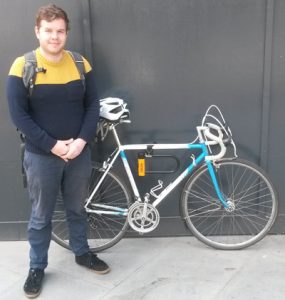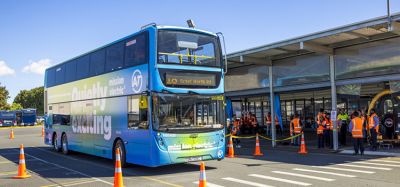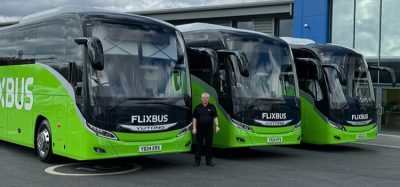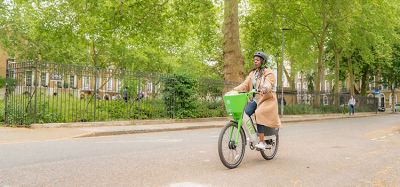Will Sadiq Khan maintain London cycling’s upwards trajectory?
- Like
- Digg
- Del
- Tumblr
- VKontakte
- Buffer
- Love This
- Odnoklassniki
- Meneame
- Blogger
- Amazon
- Yahoo Mail
- Gmail
- AOL
- Newsvine
- HackerNews
- Evernote
- MySpace
- Mail.ru
- Viadeo
- Line
- Comments
- Yummly
- SMS
- Viber
- Telegram
- Subscribe
- Skype
- Facebook Messenger
- Kakao
- LiveJournal
- Yammer
- Edgar
- Fintel
- Mix
- Instapaper
- Copy Link
Posted: 19 May 2016 | Ian Hall | No comments yet
Boris Johnson was a cyclist-friendly mayor of London. Ian Hall assesses the prospects for his successor, Sadiq Khan.
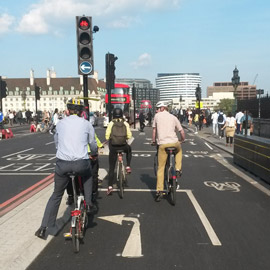

Boris Johnson was a cyclist-friendly mayor of London. Ian Hall assesses the prospects for his successor, Sadiq Khan.
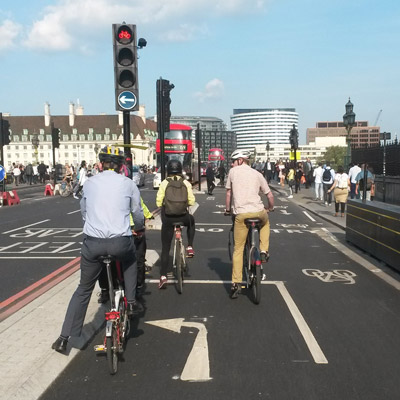

Westminster Bridge cycle lane (Photo: Ian Hall)
It was fitting – as Boris Johnson himself acknowledged – that the Conservative maverick’s final act as London mayor was to open ‘Crossrail for the Bike’: an east-west Cycle Superhighway, billed as the longest ‘substantially segregated’ urban cycle-route in Europe.
Johnson often seemed wedded to his bike during his eight years as mayor and the new route is part of his ‘Vision for Cycling’, launched to great fanfare three years ago.
With Labour’s Sadiq Khan now in charge at City Hall, will London’s push for pedal-power be sustained? And what legacy does Johnson leave?
Luke Blair, a board director at London Communications Agency (and designate vice-president of communications and public affairs at Imperial College) is a long-time observer of London politics and transport. He tells Intelligent Transport: “One has to give Boris credit where it’s due. The fact that the Mayor himself was frequently pictured riding his own bicycle around the capital probably did more for cycling than any number of super-highways and blue paint [the colour of London’s cycle lanes]. The best thing the new mayor can do to continue the fantastic increase in cyclists in recent years is – to take [Conservative grandee] Norman Tebbit’s advice, turn it into a new, much more positive sentiment, and ‘get on his bike’.”
Boris’s legacy
London Cycling Campaign’s (LCC) infrastructure campaigner Simon Munk observes that Johnson’s commitment to cyclists accelerated during his second four-year term of office. Cycling Commissioner, the journalist Andrew Gilligan, was appointed in January 2013 and infrastructure investment – beyond painting some streets with blue cycle paths – began to be more substantial.
Munk believes an LCC campaign entitled ‘Love London, Go Dutch’, during the 2012 Mayoral election campaign, was the major turning-point. The campaign called for Johnson to implement three Dutch-style infrastructure schemes; to ensure all planned developments on main roads met ‘Go Dutch’ standards, especially junctions; and for the capital’s Cycle Superhighways programme to meet the same standards.
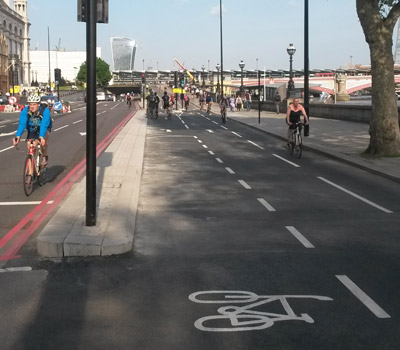

Victoria Embankment near Blackfriars (Photo: Ian Hall)
Cycling’s growth in profile and popularity can also be partly also attributed to London’s cycle-hire system launched in 2010 by Transport for London.
Although emphasising that there is considerable work still to do, Munk says “the past two years have seen more high-quality infrastructure planned for, or put into construction, in London than in arguably the past two decades”.
Sadiq’s challenge
Intelligent Transport asked the LCC what they want Khan to deliver and we reproduce extracts from an open letter – containing a three-point agenda – dispatched by the group’s CEO, Dr Ashok Sinha, to City Hall shortly after the new mayor’s election victory.
Of course, Khan needs to balance the demands other road-user lobbies. This could get fractious: the head of the Licensed Taxi Drivers’ Association (London’s biggest taxi drivers’ association) in February 2015 controversially compared cyclists to terror group, Isis, as Cycle Superhighways were given the go-ahead.
But Khan’s pre-election signals augur more green than amber (or indeed red) for cyclists. Specifically, he has promised to increase funding made available to cycling and has commented, in particular, how cycling helps addressing the problem of air pollution. So, as far as cyclists are concerned, his intentions are positive – and cycling-related announcements are expected imminently. But, of course, it will be a while before concrete actions can be assessed.
European context
Naturally, Intelligent Transport’s readers will find it particularly interesting to examine developments in London from a European perspective. In this context, it is clear that London remains – inevitably – a substantial distance behind Europe’s peloton, which remains very much headed by famed northern European cycling hotspots such as Amsterdam and Copenhagen. This is despite Boris Johnson himself earlier this month talking of ‘Amsterdam-like volumes of cyclists at peak times’ across London’s Blackfriars Bridge.
Benedicte Swennen, Urban Mobility and Cities Policy Officer at the Brussels-headquartered European Cyclists’ Federation, describes London to Intelligent Transport as “on its way to join a group of ‘climber’ cycling cities such as Berlin, Stockholm, Dublin and Vienna.”


Benedicte Swennen, Urban Mobility and Cities Policy Officer
Benedicte explains: “London is ambitious about cycling and shows it with investments in infrastructure, promotion and media actions etc., which is a very good sign. So, I would compare the city with Brussels or Paris – low mode- share, but ambitious. On the other hand, there are some important barriers in London that are not tackled yet and that are slowing the cycling revolution, such as the big safety issue. This might bring London back into a lower category of European capitals – I’m thinking about Rome, Madrid and Athens, where cycling is around one per cent of mode-share.”
Benedicte also points out that the profusion of cyclists now visible in the centre of London contrasts markedly with the suburbs.
Looking ahead
At time of writing, City Hall is acclimatising to the new mayor and political appointments are awaited. The successor to Andrew Gilligan as cycling commissioner remains to be decided.
One diary-date coming up is actually this Friday (20 May), which sees the London Cycling Awards. ‘Best Large-Scale Infrastructure Scheme’ and ‘Best Borough Infrastructure Scheme’ are among the categories.
Beyond then, LCC is organising a 400-kilometre bike-ride from London to Amsterdam in mid-September. The choice of destination is significant. As LCC acknowledges: ‘By joining us on this fantastic ride you’ll not only enjoy great company and experience the pleasures of cycling in Holland, but you’ll be helping us hugely in bringing the Dutch approach to cycling infrastructure back home to London’.
Just a few years ago this would have seemed a ludicrous pipe-dream. But, as the canapes circulate at this Friday’s awards, London’s cycling fraternity should be optimistic that cycling’s upward curve can continue.
|
London Cycling Campaign’s view
(Image: Dr Ashok Sinha, CEO, London Cycling Campaign) Extracts from an Open Letter sent by Dr Ashok Sinha, CEO, London Cycling Campaign to Sadiq Khan on 10 May 2016: Many congratulations on being elected as Mayor of London. We pay tribute to your predecessor, Boris Johnson, for the legacy he has left of new, Dutch-style cycling facilities. It is to his credit that he agreed in 2012 to meet the terms of LCC’s ‘Love London, Go Dutch’ campaign; and it is to your credit that you will build on this via the commitment you have given to achieving the three-point agenda of our 2016 ‘Sign for Cycling’ campaign. As you begin your period of office we urge you to proceed straight away towards meeting this three-point agenda. First, we call on you to achieve the tripling of protected space for cycling to which you are committed, by: ensuring there is no slowdown in TfL’s Cycle Superhighway programme; accelerating safety measures at dangerous junctions; and investing in international quality cycling provision on main roads across London. Second, we call on you to make an immediate start on your promise to create a framework for every borough to access funding for ‘Mini-Holland’ style schemes, delivering investment in cycling and walking to town centres, high streets or other areas of economic-social activity. We know from past experience that such schemes require considerable planning and preparation, so the sooner you begin, the sooner people wishing to make local journeys by cycle will have the chance to do so more safely and enjoyably. We look forward to seeing an announcement in the coming months. Third, we ask that you commission work immediately to fulfil your promise on ‘Direct Vision’ lorries – i.e. making them the norm on London’s streets. Rightly, you have said that the first step is to make sure TfL and the rest of the GLA group takes action – it must only procure goods and services from operators using the safest lorry designs; and you have also agreed to use the planning, regulatory and other powers at your disposal to influence the wider market. HGV manufacturers and operators need certainty when planning for the renewal of their fleets: we therefore call on you to make sure a comprehensive framework is in place during the course of your first year in office that gives confidence to the market, so that the fastest possible rate of replacement of old stock with new, direct vision lorries will occur. Finally, we thank you once again for making such clear and measureable commitments to achieving the environmental, health, and quality of life benefits that mass uptake of cycling will bring to London and its rapidly growing population – not to mention the pressure this will take off the public transport system and the alleviation of congestion on our roads. The London Cycling Campaign will monitor progress with keen interest and help in any way we can. |
|
A London cyclist’s view
Kevin McCann, 28, works for a charity in east London On average I probably ride about 40 miles a week, in and around Hackney. I used to cycle when I lived in Brighton, and was unsure if I would continue when I came to London – but it’s the best decision I’ve made since moving here. I cycle pretty much everywhere, but if it’s pouring with rain then I don’t beat myself up about taking the bus. Sadiq Khan should build on the progress that has been made in the past few years. The Cycle Superhighways are great, and TfL has done a good job of improving things such as junctions, although there are still far too many lethal roundabouts. The new phased traffic-lights help cyclists and drivers alike when there’s no segregation. But the ‘soft’ infrastructure helps a lot as well. More secure, dry bike parking across the city – on the street but also in offices and new housing developments, and near other transport hubs – would be a good place to start. Something that I think would be fantastic would be a comprehensive new signage system to help cyclists navigate – it’s amazing how much more difficult it is to know where you’re going on a bike, compared with being in a car. |
From Boris Bikes to Sadiq Cycles? Ian Hall recently blogged about London’s cycle-hire scheme – you can read this blog here.
Related topics
Business Models, Fleet Management & Maintenance, Mobility Services, Multimodality, Ticketing & Payments, Transport Governance & Policy
Related people
Ian Hall




